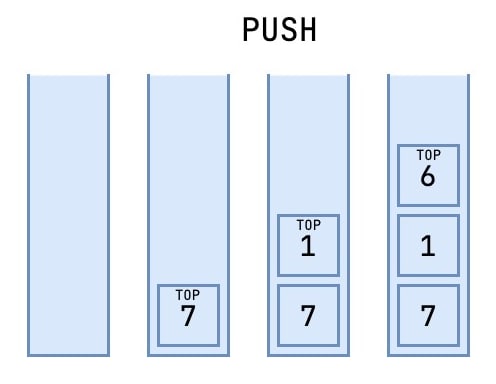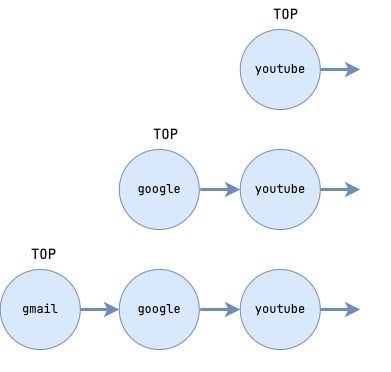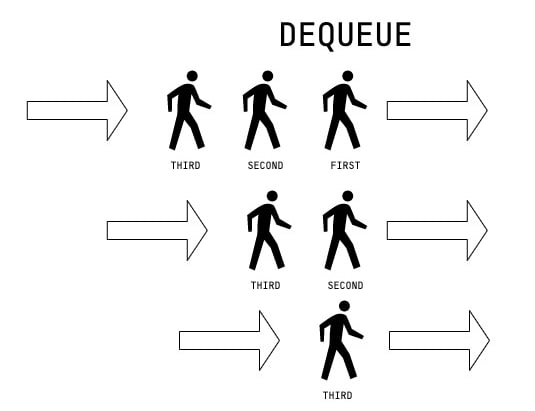目录
堆
堆栈是一种数据结构,其中将项目添加和删除,以结束,首先(LIFO)顺序。将元素插入堆栈被称为“推动”操作,删除元素称为“ pop”操作。
简单示例:图像您打开浏览器,然后访问youtube.com,然后访问google.com,最后是gmail.com。
您当前的浏览历史记录看起来像这样('gmail.com'是您当前打开的网站):
youtube.com->google.com->gmail.com
在实践中使用堆栈的一个示例是在网络浏览器中单击“返回”按钮时,该按钮可让您在离开它之后返回上一个网页Google.com,而当前的网页gmail.com正在从堆栈的顶部取出。
youtube.com->google.com
如果您再次单击返回,您就回来了。
youtube.com
堆栈中的节点
一个节点是一个基本单元,可存储一块数据并引用列表中的下一个和上一个节点。类似于单链接列表。
class Node
{
public $value;
public $next;
public function __construct($value)
{
$this->value = $value;
$this->next = null;
}
}
此节点类有两个字段:
1,存储元素值的数据,
2,下一步,是对列表中的下一个节点的引用
堆栈中的构造函数
让我们创建一个代表堆栈数据结构的类。
此类有两个实例变量:
-
$top:对列表中的第一个节点的引用, -
$height:一个数量计算堆栈中节点数量的整数(这是1个,因为我们在构造函数中创建了一个新节点)。
class Stack
{
public $top;
public $height;
public function __construct(public $value)
{
$newNode = new Node($value);
$this->top = $newNode;
$this->height = 1;
}
}
在转到主要操作之前,让我们创建一个辅助方法来打印堆栈中的所有节点。
说明:
在方法printStack()中,我们定义了局部变量$temp,并分配了 $ this-> top的值,这是对列表中的第一个节点的引用。
然后,它进入一个段循环,直到$temp不为空,这意味着没有更多的 next 节点。
呼应值后,该函数分配了$temp $temp->next的值,将$temp移至列表中的下一个节点 ,以继续循环。
public function printStack()
{
$temp = $this->top;
while ($temp != null) {
echo $temp->value."\n";
$temp = $temp->next;
}
}
推
当我们将节点“按”堆栈上时,我们将一个新元素添加到堆栈顶部。堆栈遵循LIFO(最后一次)原理,这意味着添加到堆栈中的最后一个元素将是第一个要删除的元素。因此,当您将新节点推入堆栈时,该新节点将是堆栈的新顶级节点。
在图像中从左到右,我们正在添加值。首先,7,然后是最终6。
说明:
- 我们创建一个新节点。
- 如果堆栈为空,则将新节点分配为第一个节点,而顶部引用则指向它。
- 如果堆栈不是空的,则使用下一个引用将新节点连接到当前顶部节点。
- 顶部引用已更新为新节点。
- 最后,我们增加了堆栈的计数(高度)。
public function push($value)
{
$newNode = new Node($value);
if ($this->height == 0) {
$this->top = $newNode;
} else {
$newNode->next = $this->top;
$this->top = $newNode;
}
$this->height++;
}
// $s = new Stack('youtube.com');
// $s->push('google.com');
// $s->push('gmail.com');
// $s->printStack();
//
// gmail.com
// google.com
// youtube.com
流行音乐
“ pop”是堆栈上的一个操作,该操作可去除堆栈顶部的元素并返回。该操作还将堆栈的顶部引用更新为下一个元素,并减少堆栈的计数(高度)。
记住:要成为堆栈的事物,您只需要从同一端添加和删除即可。
在图像中从左到右,我们正在删除值。首先,6,然后是最终。
说明:
- 如果堆栈为空,我们返回null。
- 其他,我们为堆栈的当前顶部分配一个临时变量。
- 我们将堆栈中下一个元素的最高引用更改为
- 一旦更改了顶部,我们就可以将上一个顶部(存储在临时变量中)重置为null。
- 最后,我们减少了堆栈的计数(高度)。
从上到下,当我们单击“返回”按钮时,我们访问了以前的网站,这些网站彼此之间是“堆叠”的。
public function pop()
{
if ($this->height == 0) {
return null;
}
$temp = $this->top;
$this->top = $this->top->next;
$temp->next = null;
$this->height--;
return $temp;
}
// $s = new Stack('youtube.com');
// $s->push('google.com');
// $s->push('gmail.com');
// $s->pop(); // removes top
// $s->printStack();
//
// google.com
// youtube.com
在数组中堆叠
在PHP中,诸如Array_push和Array_pop之类的内置函数可用于使用数组数据结构实现堆栈。
$stack = [];
array_push($stack, 'youtube.com');
array_push($stack, 'google.com');
array_push($stack, 'gmail.com');
array_pop($stack);
// $stack = [
// "youtube.com",
// "google.com",
// ]
使用array_push和array_pop函数实现阵列推动和弹出操作的时间复杂性,平均为o(1)。
注意: 当您使用array_unshift和array_shift函数实现时,您可以在数组中预处和弹出第一个元素时也可以实现堆栈原理,但是是o(n)在最坏的情况下。
堆栈中的时间复杂性
push:o(1) - 此操作需要持续的时间,因为它仅涉及在堆栈顶部添加一个元素。
POP:O(1) - 此操作也需要持续的时间,因为它仅涉及从堆栈中删除顶部元素。
注意: 这些复杂性用于使用数组或链接列表的堆栈和队列的基本实现。
队列
队列是线性数据结构,其中添加的第一个元素是第一个要删除的元素。该订单被称为首先出局(FIFO)。
队列的一个普遍例子是等待命令的人,首先到达的人将首先提供。队列和堆栈之间的主要区别在于如何去除元素。在堆栈中,最近添加的元素首先被删除,而在队列中,最近添加的元素首先被删除。
完整脚本:
https://gist.github.com/matusstafura/4bd1beeba61f1995b3fcd18a77bf87c6
队列中的节点
我们使用与堆栈相同的定义。
class Node
{
public $value;
public $next;
public function __construct($value)
{
$this->value = $value;
$this->next = null;
}
}
队列中的构造函数
让我们创建一个代表队列数据结构的类。
此LinkedList类有三个实例变量:
-
$first:对列表中的第一个节点的引用, -
$last:对列表中的最后一个节点的引用, -
$length:一个数量计算列表中节点数量的整数。
class Queue
{
public $first;
public $last;
public $length;
public function __construct(public $value)
{
$newNode = new Node($value);
$this->first = $newNode;
$this->last = $newNode;
$this->length = 1;
}
}
用于打印我们使用与堆栈中的回声值相同的逻辑。
public function printQueue()
{
$temp = $this->first;
while ($temp != null) {
echo $temp->value."\n";
$temp = $temp->next;
}
}
入住
进入Queue意味着将新节点添加到队列(也称为推送,添加或插入操作)。
从上到下,我们正在为队列添加值。
说明:
- 我们创建一个新节点。
- 如果队列为空,则将新节点分配为第一个和最后一个节点。
- 如果队列不是空的,则最后一个节点的下一个引用已连接到新节点。
- 最后一个引用已更新为新节点。
- 我们增加了队列的长度。
public function enqueue($value)
{
$newNode = new Node($value);
if ($this->length == 0) {
$this->first = $newNode;
$this->last = $newNode;
} else {
$this->last->next = $newNode;
$this->last = $newNode;
}
$this->length++;
}
// $q = new Queue("first customer");
// $q->enqueue("second customer");
// $q->enqueue("third customer");
//
// $q->printQueue();
// first customer
// second customer
// third customer
Dequeue
到“ Dequeue”(也称为pop,删除或删除)是指删除队列前部元素的操作。
从上到下,我们将值删除到队列
队列遵循第一个第一(FIFO)排序原则,因此我们需要删除第一个。
说明:
- 如果队列为空,我们返回null。
- 如果队列只有一个节点,我们将其第一个也是最后一个引用。
- 否则,我们将第一个引用分配给下一个节点。
- 我们通过将其重置为null。
- 最后,我们降低了队列的长度。
public function dequeue()
{
if ($this->length == 0) {
return null;
}
$temp = $this->first;
if ($this->length == 1) {
$this->first = null;
$this->last = null;
} else {
$this->first = $this->first->next;
$temp->next = null;
}
$this->length--;
return $temp;
}
// $q = new Queue("first customer");
// $q->enqueue("second customer");
// $q->enqueue("third customer");
// $q->dequeue();
//
// $q->printQueue();
// second customer
// third customer
阵列中的队列
$stack = [];
array_push($stack, 'youtube.com');
array_push($stack, 'google.com');
array_push($stack, 'gmail.com');
array_shift($queue);
// $stack = [
// "google.com",
// "gmail.com",
// ]
在此示例中,array_push函数的时间复杂性为o(1),对于php中的array_shift函数为o(n),其中n是输入数组的大小。
队列中的时间复杂性
在我们的链接列表示例中:
顾问:o(1) - 此操作需要恒定时间,因为它仅涉及在队列的背面添加一个元素。
Dequeue:O(1) - 此操作需要恒定时间,因为它仅涉及从队列中删除前元素。
完整脚本:
https://gist.github.com/matusstafura/e70b13f3cbf38a3efc00b3dcb561bb59





